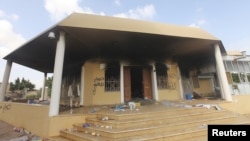A U.S. Department of Defense timeline released Friday indicates that Pentagon leaders knew of the September 11 attack on the U.S. Consulate in Benghazi an hour after it began, but were unable to mobilize reinforcements based in Europe in time to prevent the deaths of four Americans, including the U.S. ambassador.
Defense Secretary Leon Panetta and his top military advisor were notified about the attack 50 minutes after it started.
Panetta and Army General Martin Dempsey, the chairman of the Joint Chiefs of Staff, went to a previously scheduled meeting at the White House with President Barack Obama less than 30 minutes later discussing potential responses to the unfolding situation in Benghazi, where militants had surrounded the consulate and set in on fire.
U.S. Ambassador Christopher Stevens was killed in the attack.
The Pentagon released the timeline to answer lingering questions about the circumstances surrounding the assault on the consulate and the ambassador's death. During the recent U.S. presidential election, Republican challenger Mitt Romney accused President Obama of mishandling the attack.
Defense Secretary Panetta has repeatedly said there were no armed aircraft or military teams near Benghazi that could have gotten there quickly.
After Panetta and Dempsey left the White House that day, they went to the Pentagon for a series of meetings to organize responses to the attack.
As they arrived at the Pentagon, the surviving personnel from the consulate in Benghazi were being evacuated by a CIA team that arrived from a nearby base.
Panetta and his senior advisors continued to meet and Panetta issued verbal orders for anti-terrorism teams in Europe to deploy to Libya.
By the next day, all the Americans, including the dead, were flown out of Benghazi.
Defense Secretary Leon Panetta and his top military advisor were notified about the attack 50 minutes after it started.
Panetta and Army General Martin Dempsey, the chairman of the Joint Chiefs of Staff, went to a previously scheduled meeting at the White House with President Barack Obama less than 30 minutes later discussing potential responses to the unfolding situation in Benghazi, where militants had surrounded the consulate and set in on fire.
U.S. Ambassador Christopher Stevens was killed in the attack.
The Pentagon released the timeline to answer lingering questions about the circumstances surrounding the assault on the consulate and the ambassador's death. During the recent U.S. presidential election, Republican challenger Mitt Romney accused President Obama of mishandling the attack.
Defense Secretary Panetta has repeatedly said there were no armed aircraft or military teams near Benghazi that could have gotten there quickly.
After Panetta and Dempsey left the White House that day, they went to the Pentagon for a series of meetings to organize responses to the attack.
As they arrived at the Pentagon, the surviving personnel from the consulate in Benghazi were being evacuated by a CIA team that arrived from a nearby base.
Panetta and his senior advisors continued to meet and Panetta issued verbal orders for anti-terrorism teams in Europe to deploy to Libya.
By the next day, all the Americans, including the dead, were flown out of Benghazi.
